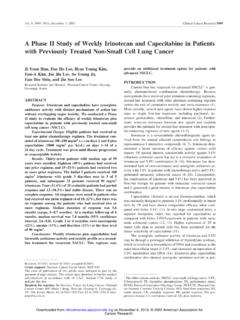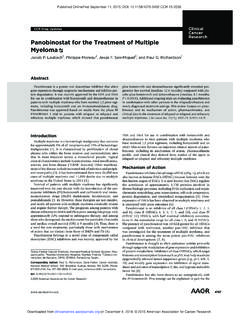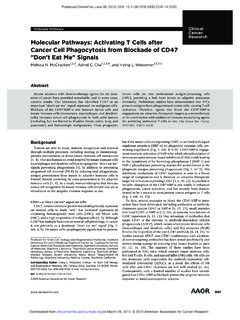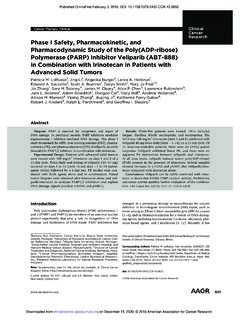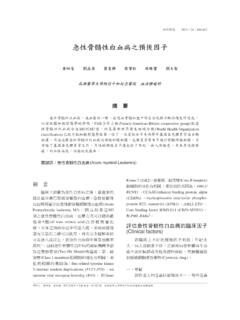Transcription of A Leukemia-Associated CD34/CD123/CD25/ …
1 Biology of Human TumorsA Leukemia-Associated CD34/CD123/CD25/ CD99 immunophenotype IdentifiesFLT3- mutated clones in Acute Myeloid LeukemiaDaniela F. Angelini1, Tiziana Ottone2,3, Gisella Guerrera1, Serena Lavorgna2,3,Michela Cittadini2,3, Francesco Buccisano2, Marco De Bardi1, Francesca Gargano1,Luca Maurillo2, Mariadomenica Divona2,N elida I. Noguera3,4, Maria Irno Consalvo2,Giovanna Borsellino1, Giorgio Bernardi5, Sergio Amadori2, Adriano Venditti2,Luca Battistini1, and Francesco Lo-Coco2,3 AbstractPurpose:We evaluated Leukemia-Associated immunopheno-types (LAIP) and their correlation with fms-like tyrosine kinase 3( flt3 ) and nucleophosmin (NPM1) gene mutational status inordertocontributeabetteridentification ofpatientsathighestriskof relapse in acute myeloid leukemia (AML).Experimental Design:Bone marrow samples from 132patients with AML were analyzed by nine-color multiparametricflow cytometry. We confirmed the presence of the mutation indiagnostic samples and in sorted cells by conventional RT-PCRand by patient-specific :Within the CD34 cell fraction, we identified adiscretepopulation expressing high levels of the IL3 receptora-chain(CD123) and MIC-2 (CD99) in combination with the IL2 recep-tora-chain (CD25).
2 The presence of this population positivelycorrelated with the internal tandem duplications (ITD) mutationin theFLT3gene (r ). Receiver operating characteristicsshowed that, within the CD34 cell fraction a percentage ofCD123/CD99/CD25 cells predictedFLT3 ITD muta-tions with a specificity and sensitivity of>90%. CD34/CD123/CD99/CD25 clones were also detectable at presentation in 3patients withFLT3wild-type/NPM1 AML who relapsed withFLT3-ITD/NPM1 AML. Quantitative real-time PCR designed atrelapse for eachFLT3-ITD in these three cases confirmed thepresence of low copy numbers of the mutation in :Our results suggest that the CD34/CD25/CD123/CD99 LAIP is strictly associated withFLT3-ITD Cancer Res; 21(17); 3977 85. 2015 by multiparametricflow cytometry(MPFC) is a valuable and effective tool for diagnostic character-ization, classification, and minimal residual disease (MRD) mon-itoring in acute myeloid leukemia (AML). In fact, several studieshave defined surface and cytoplasmic markers that are aberrantlyexpressed on AML blasts at diagnosis (1, 2); these combinationsmay identify Leukemia-Associated immunophenotypes (LAIP),which allow sensitive monitoring of MRD during follow-up(3 5).
3 Compared with molecular evaluation of MRD throughPCR amplification of genetic AML lesions, MPFC offers theadvantage of being applicable to the vast majority ( ,>90%)of cases (6, 7).In addition to immunophenotype , both karyotypic and molec-ular genetic characterization are essential parts of the diagnosticwork-up in AML. Although in some cases immunophenotypicprofiles have been correlated with AML genetic subsets, to date noantigenicsignaturehasbeenassociatedwit hanAMLgeneticentitywith absolute specificity. For instance, expression of CD14, CD4,CD11b, and CD64 or CD36 (markers of monocytic and granu-locytic differentiation) combined with high levels of CD34 andCD117 and abnormal expression of CD2 characterizes but isnot specific for AML inv (16) or t(16;16) (8). Similarly, acutepromyelocytic leukemia (APL) with t(15;17) is characterized byvery low or absent expression of CD34 and HLA-DR, and posi-tivity for CD117/CD33; however, this antigenic profile is notcompletely specific for APL and some variant LAIPs have beendescribed (9 11).
4 Several studies have reported correlations of aberrantlyexpressed markers with clinical outcome in AML. For example,CD7 and CD25 expression has been associated with poor prog-nosis in normal karyotype (NK) AML (12 14). The IL3 receptor-a(CD123)is overexpressedin45% ofAMLpatients, and thishigherexpression has also been associated with poor outcome (15).Finally, overexpression of CD123 has been correlated in this1 Neuroimmunology and Flow Cytometry Units, Fondazione , Rome, of Biomedicine and Preven-tion, University of Tor Vergata, Rome, di Neuro-Oncoematologia, Fondazione Santa Lucia , Rome, of Chemical Biochemistry (Hematology), National Uni-versity of Rosario, Neuroscience, Fonda-zione Santa Lucia, , Rome, :Supplementary data for this article are available at Clinical CancerResearch Online ( ). Angelini and T. Ottone contributed equally to this Author:Francesco Lo-Coco, Department of Biomedicine andPrevention, University Tor Vergata, Via Montpellier 1, 00133 Rome, Italy.
5 2015 American Association for Cancer November 25, 2018. 2015 American Association for Cancer Downloaded from Published OnlineFirst May 8, 2015; DOI: setting with mutations in the fms-like tyrosine kinase receptor( flt3 ) gene (16).A consistent antigenic profile with high CD33 expression hasalso been associated with AML with mutated nucleophosmin(NPM1; refs. 17 and 18). Patients withNPM1- mutated AML havefavorable prognosis except when this gene alteration is accom-panied byFLT3lesions and in particular by internal tandemduplications ( flt3 -ITD), which are universally regarded as pre-dictor of a poor outcome (19 22).Screening by PCR forFLT3-ITDat diagnosis is relevant for riskstratification of AML patients; however, this technique is neithersufficiently sensitive nor it may be routinely applied to MRDmonitoring due to the instability of this alteration and its inter-patient variability. Recent studies suggest thatFLT3-ITD AMLrelapse may occasionally originate from very small subclones,which are undetectable at diagnosis by routine screening (23).
6 Wehave previously developed a patient-specific real-time quantita-tive PCR to implementFLT3-ITD detection at time of relapse (24),but this approach is unfortunately not applicable at diagnosis tounravel minorFLT3-ITD subclones. Through this assay, we ana-lyzed paired diagnostic and relapse samples in AML patients whohad showedFLT3-ITD only at relapse by conventional found that smallFLT3-ITD clones that were chemoresistantand eventually gave origin to disease relapse were already presentat diagnosis in these patients (24). Thesefindings highlight theneed of improving diagnostic identification in AML of smallnumber of cells harboring genetic lesions associated with ,wesoughttoinvestigatewhethernine-colorM PFC could be helpful to detect minor subclones potentially associatedwith resistance and disease recurrence in AML. We combinedtypical markers of early myeloid progenitors including CD34,CD117, CD38, with markers associated withFLT3mutations,such as CD123, CD25, and CD7.
7 This approach allowed us toidentify a subset of CD34 cells whose presence is highly predic-tive of theFLT3mutations in and MethodsPatientsA total of 132 consecutive patients ages 19 to 85 years withnewly diagnosed AML observed and treated at the HematologyUnit of the Department of Biomedicine and Prevention of theUniversity of Tor Vergata during the period 2012 to 2014 wereincluded in the study. The vast majority of patients ages<75 yearsreceived intensive chemotherapy according to European Organi-zation of Research and Treatment of Cancer (EORTC)/GruppoItaliano Malattie EMatologiche dell'Adulto (GIMEMA) protocols,whereas patients ages>75 years received supportive care ortherapy with hypomethylating agents. According to the declara-tion of Helsinki, all patients gave informed consent for the studythat was approved by the Institutional Review Board of thePoliclinico Tor Vergata of work-upRoutine morphologic, immunophenotypic, and geneticanalyses were carried out in all cases at presentation.
8 Conven-tional karyotyping was performed on bone marrow (BM)diagnostic aspirates after short-term culture and analyzed afterG-banding. The description of the karyotypes was done accord-ing to the International System for Human CytogeneticNomenclature. As for molecular analysis, total RNA wasextracted from Ficoll-Hypaque isolated BM mononuclear cellscollected at diagnosis and for selected cases, during follow-upusing standard procedures (25) and reverse-transcribed withrandom hexamers as primers. DNA was extracted using acolumn-based Qiagen Kit protocol (Qiagen). RNA samplesextracted from sorted cells population were subjected toreverse-transcription using 200 ng of RNA with the SuperScriptIII One-Step RT-PCR system (Invitrogen) according to themanufacturer's instructions. Most common AML gene fusions,FLT3status (both ITD and TKD mutations) andNPM1mutated(mut) or wild-type (wt) gene status were investigated using theprotocols reported elsewhere (19, 26, 27). For selected patients,theFLT3-ITD data are also represented as a ratio of mut/wt cellsobtained by a quantitative assay based on Genescan analysis(19).
9 This assay compares the relative abundance of wt studies and high-speed cell sortingImmunophenotypic studies were performed on BM samples atdiagnosis and, for selected cases, in samples obtained duringfollow-up and at disease relapse. Cells were acquired on a CyAnADP 9 Color equipped with three lasers (Beckman Coulter, Brea,CA). Briefly, BM samples were lysed with ammonium chloride(pH ) and stained with predefined optimal concentrations of 8antibodies and a dead cell stain dye (LIVE/DEAD Fixable AquaDead Cell Stain Kit, Life Technologies). Each sample at diagnosiswas stained with 10 distinct antibody combinations ("pre-mixes"); the markers CD45, CD34, CD117 and HLA-DR repre-sented the "backbone" and were present in all combinations, inaddition to a viability stain. The remaining 4 markers weredifferent in each mix. The number of events acquired for eachleukemic sample was determined as to have at least 500 eventsaccumulated in the gate of CD34 cells. Events analyzed undergofurther back gating analysis (CD45 vs side scatter) and exclusionof doublets and dead cells.
10 Following acquisition and analysis ofthe samples stained with the 10 pre-mixes, new antibody combi-nationsweredesignedonthespottoincl udeallmarkersexpressedby the leukemic cells, thus each sample was studied specificallyusing custom-designed panels. Data were analyzed using FlowJosoftware (TreeStar Inc.).High-speed cell sorting was performed on a Moflo (BeckmanCoulter). Cells were isolated by Ficoll-Hypaque to preventTranslational RelevanceAlthough it is well established that flt3 mutations conferpoor prognosis in AML, the significance of minor clonesharboring this alteration is unclear. Furthermore, such clonesare not easily detectable through molecular assays. We showhere that minorFLT3-ITD positive subclones are clinicallyrelevant in AML as they may emerge after therapy in patientslabeled as flt3 wild-type at presentation. Identificationthrough multiparametricflow cytometry at diagnosis of animmunophenotypicfingerprint associated with these sub- clones is a novel and simplified tool with improved sensitivityto unravel these clones and allowing patient stratification andrisk-adapted treatment with potential impact on outcome ofthe et Cancer Res; 21(17) September 1, 2015 Clinical Cancer Research3978on November 25, 2018.
